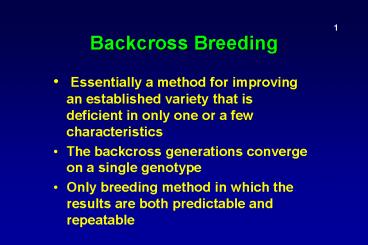Backcross Breeding
1 / 17
Title: Backcross Breeding
1
Backcross Breeding
1
- Essentially a method for improving an
established variety that is deficient in only one
or a few characteristics - The backcross generations converge on a single
genotype - Only breeding method in which the results are
both predictable and repeatable
2
Requirements
2
- A satisfactory recurrent parent, usually an
established cultivar - A donor parent with a desirable characteristic
- A sufficient number of backcrosses to
reconstitute the recurrent parent
3
Implementation
3
- A cross is made between the Donor and
Recurrent parent, then the F1 and subsequent
generations are crossed (backcrossed) to the
recurrent parent - The backcross generations converge on a single
genotype - The genetic contribution of the Donor parent
will be halved each generation
4
Recovery of recurrent parent
4
- Generation Recurrent parent
- F1 50
- BC1 75
- BC2 87.5
- BC3 93.75
- BC4 96.87
- etc...
- same rate as homozygosity in a selfing
series
1- (1/2)m, where m number of generations of
backcrossing or selfing
5
Proportion of homozygous genotypes
5
- Example 1
- Assuming 3 loci and 3 backcrosses
- (23 - 1) / (23)3 .669
- Example 2
- Assuming 10 loci and 5 backcrosses
- (25 - 1) / (25)10 .728
(2m - 1) / (2m)n m number of
generations of backcrossing or selfing n number
of heterozygous loci in F1
6
Rate of inbreeding
6
7
Features of Backcross method
7
- Provides breeder a high degree of control
- Traits to be improved can be described in advance
- It is repeatable
- Extensive field trials are not required
- Few notes (record keeping)
8
Negative Features
8
- Improved variety is same as recurrent
parent except for trait transferred - Minimal recombination
- Linkages to deleterious genes
- Not effective for quantitative traits
9
Backcrossing dominant gene for rust resistance
9
- Parker P1 (rr) x Baart P2 (RR)
- F1 (Rr) (resistant)
- BC1 Parker (rr) 1/2 rr 1/2 Rr (inoculate )
- BC2 Parker (rr) 1/2 rr 1/2 Rr (inoculate )
- BC3 Parker (rr) 1/2 rr 1/2 Rr (inoculate )
After BC, then self
10
Backcrossing a recessive gene for rust resistance
11
- Recurrent P1 (RR) x Donor P2 (rr)
- F1 (Rr) (suseptable)
- BC1 Recurrent (RR) 1/2 RR 1/2 Rr (suseptable
) - How to identify the heterozygotes carrying the
- desirable recessive gene for resistance?
- 1) Progeny test
- 2) Blind backcross
11
Blind backcrossing
12
- Recurrent P1 (RR) x donor P2 (rr)
- F1 (Rr) (suseptable)
- BC1 RCP (RR) 1/2 RR 1/2 Rr
- BC2 RCP (RR) 3/4 RR 1/4 Rr
- BC3 RDC (RR) 7/8 RR 1/8 Rr (self and
inoculate to recover rr
individuals)
12
Backcrossing more than one gene
13
- Recurrent (P1) X Donor (P2)
- AABB aabb
- F1 AaBb
- AABB AABB AaBB AABb AaBb
- (only 1/4 of plants contain both a and b
alleles)
13
Number of plants required
14
14
Marker facilitated backcrossing
15
- Two objectives
- Transfer of trait
- Recovery of recurrent parent genotype
- Can use selection based on phenotypes in early
backcross generations to shift population towards
recurrent parent - Molecular markers can also be used to
characterize individuals in early generations.
15
F2 population
16
- Indiv M1 M2 M3 M4
- 1 R H D R 5/8
- 2 D H D R 3/8
- 3 R H D H 4/8
- 4 R H R R 7/8
- R homozygous for recurrent parent genotype (2)
- H heterozygous (1)
- D homozygous for donor parent genotype (0)
16
F2 and BC1 distributions
17
Backcross
15 gt90RCP
F2
3 gt90RCP
17
Backcross generations
18
- P1 (BB) x P2 (bb)
- F1 (Bb) x P1 (BB)
- Backcross progeny
- BB Bb 1/2 1/2 a d Mean
1/2a 1/2d - Variance 1/4a2 1/4d2 - 1/2ad
- Note if d0, then Variance of BC is 1/2 that of
F2
homozygous for recurrent parent genotype
homozygous for recurrent parent genotype































